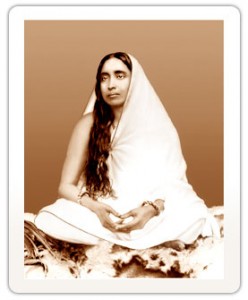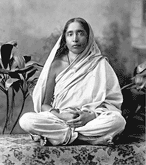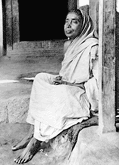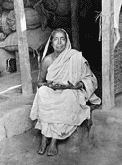Sri Sarada Devi
The Holy Mother -Sri Sarada Devi
Endearingly known as ‘Holy Mother’, Sri Sarada Devi, the spiritual consort of Sri Ramakrishna, was born on 22 December 1853 in a poor Brahmin family in Jayrambati, a village adjoining Kamarpukur in West Bengal. Her father, Ramachandra Mukhopadhyay, was a pious and kind-hearted person, and her mother, Shyama Sundari Devi, was a loving and hard-working woman.Marriage As a child Sarada was devoted to God, and spent most of her time helping her mother in various household chores like caring for younger children, looking after cattle and carrying food to her father and others engaged in work in the field. She had no formal schooling, but managed to learn the Bengali alphabet. When she was about six years old, she was married to Sri Ramakrishna, according to the custom prevalent in India in those days. However, after the event, she continued to live with her parents, while Sri Ramakrishna lived a God-intoxicated life at Dakshineshwar.Visit to Dakshineshwar At the age of eighteen she walked all the way to Dakshineshwar to meet her husband. Sri Ramakrishna, who had immersed himself in the intense practice of several spiritual disciplines for more than twelve years, had reached the highest state of realization in which he saw God in all beings. He received Sarada Devi with great affection, and allowed her to stay with him. He taught her how to lead a spiritual life while discharging her household duties. They led absolutely pure lives, and Sarada Devi served Sri Ramakrishna as his devoted wife and disciple, while remaining a virgin nun and following the spiritual path.Life at Dakshineshwar
Sri Ramakrishna looked upon Sarada Devi as a special manifestation of Divine Mother of the universe. In 1872, on the night of the Phala-harini-Kali-puja, he ritualistically worshipped Sarada Devi as the Divine Mother, thereby awakening universal Motherhood latent in her. When disciples began to gather around Sri Ramakrishna, Sarada Devi learned to look upon them as her own children. The room in which she stayed at Dakshineshwar was too small to live in and had hardly any amenities; and on many days she did not get the opportunity of meeting Sri Ramakrishna. But she bore all difficulties silently and lived in contentment and peace, serving the increasing number of devotees who came to see Sri Ramakrishna.
Leading the Sangha after the Master’s Passing
After Sri Ramakrishna’s passing away in 1886, Sarada Devi spent some months in pilgrimage, and then went to Kamarpukur where she lived in great privation. Coming to know of this, the disciples of Sri Ramakrishna brought her to Kolkata. This marked a turning point in her life. She now began to accept spiritual seekers as her disciples, and became the open portal to immortality for hundreds of people. Her great universal mother-heart, endowed with boundless love and compassion, embraced all people without any distinction, including many who had lived sinful lives.
When the Western women disciples of Swami Vivekananda came to Kolkata, the Holy Mother accepted them with open arms as her daughters, ignoring the restrictions of the orthodox society of those days. Although she had grown up in a conservative rural society without any access to modern education, she held progressive views, and whole-heartedly supported Swami Vivekananda in his plans for rejuvenation of India and the uplift of the masses and women. She was closely associated with the school for girls started by Sister Nivedita.
She spent her life partly in Kolkata and partly in her native village Jayrambati. During the early years of her stay in Kolkata, her needs were looked after by Swami Yogananda, a disciple of Sri Ramakrishna. In later years her needs were looked after by another disciple of Sri Ramakrishna, Swami Saradananda, who built a new house for her in Kolkata.
Simplicity and Forbearance
Although she was highly venerated for her spiritual status, and literally worshipped as the Divine Mother, she continued to live like a simple village mother, washing clothes, sweeping the floor, bringing water from the pond, dressing vegetables, cooking and serving food. At Jayrambati she lived with her brothers and their families. They gave her endless troubles but, established as she was in the awareness of God and in Divine Motherhood, she always remained calm and self-possessed, showering love and blessings on all who came into contact with her. As Sister Nivedita stated, “Her life was one long stillness of prayer.”
Mother of All
In the history of humanity there has never been another woman who looked upon herself as the Mother of all beings, including animals and birds, and spent her whole life in serving them as her children, undergoing unending sacrifice and self-denial. About her role in the mission of Sri Ramakrishna on earth, she stated: “My son, you know the Master had a maternal attitude (matri-bhava) towards every one. He has left me behind to manifest that Divine Motherhood in the world.”
Ideal Woman
On account of her immaculate purity, extraordinary forbearance, selfless service, unconditional love, wisdom and spiritual illumination, Swami Vivekananda regarded Sri Sarada Devi as the ideal for women in the modern age. He believed that with the advent of Holy Mother, the spiritual awakening of women in modern times had begun.
Last Days
Under the strain of constant physical work and self-denial and repeated attacks of malaria, her health deteriorated in the closing years of her life, and she left the mortal world on 21 July 1920.
Chronology of Main Events related to Sri Maa Sarada Devi’s Life
| Year | Event |
| 1853 December 22 | Birth |
| 1859 May | Marriage and first visit to Kamarpukur |
| 1860 December | Second visit to Kamarpukur |
| 1866 May (?) | Third visit to Kamarpukur |
| 1866 December – 1867 January | Fourth visit to Kamarpukur |
| 1867 May – November | Fifth visit to Kamarpukur |
| 1872 March (?) | First visit to Dakshineshwar |
| 1872 June 5 | Shodashi-puja |
| 1873 Middle | At Jayrambati |
| 1874 March 26 | Death of her father |
| 1874 Middle | Second visit to Dakshineshwar |
| 1875 September | At Jayrambati |
| 1875 | Severe attack of dysentery and awakening of Simhavahini |
| 1875 November | Commencement of Jagaddhatri worship |
| 1876 February 27 | Death of her mother-in-law, Chandramani Devi |
| 1876 April | Shambhu Babu’s donation of a house |
| 1877 January | Third visit to Dakshineshwar (Meeting with robbers at Telo-bhelo) |
| 1881 February or March | Fourth Visit to Dakshineshwar |
| 1882 February | Fifth visit to Dakshineshwar |
| 1884 | Sixth visit to Dakshineshwar |
| 1885 March | Seventh visit to Dakshineshwar |
| 1885 October | With Sri Ramakrishna at Shyampukur |
| 1885 December 11 | With Sri Ramakrishna at Cossipore |
| During this period | Vow of fast at Tarakeshwar |
| 1886 August 16 | Passing away of Sri Ramakrishna |
| 1886 August 30 | First pilgrimage to North India (mainly Vrindavan) |
| 1887 from September | At Kamarpukur (for about nine months) |
| 1888 up to October | At Nilambar Mukherjee’s garden-house (Belur) |
| 1888 from November | At Puri |
| 1889 from February | At Kamarpukur |
| 1890 March 25 | Pilgrimage to Gaya |
| 1890 October | At Jayrambati |
| 1893 | At Nilambar Babu’s garden-house |
| 1895 | Second pilgrimage to Vrindavan |
| 1904-05 | Second pilgrimage to Puri |
| 1906 end of January | Death of Shyamasundani Devi, mother of Sri Sarada Devi |
| 1907 October | Durga worship at Girish’s house |
| 1909 May 23 | First visit to the ‘Udbodhan’ |
| 1910 December | At Kothar in Orissa |
| 1911 February-March | In the South |
| 1911 June 10 | Marriage of Radhu, niece of Sri Sarada Devi |
| 1912 October 16-21 | Durga worship at Belur |
| 1912 November 5 –January 15 | At Varanasi |
| 1915 August – September | At Koalpara |
| 1916 May 15 | In the new house at Jayrambati |
| 1916 October 3-6 | Durga worship at Belur |
| 1920 July 21 | Mahasamadhi |
- God is one’s very own. It is an eternal relationship.Ordinary human love results in misery. Love for God brings blessedness.One who makes a habit of prayer will easily overcome all difficulties.As wind removes the cloud, so the Name of God destroys the cloud of worldliness.
- My child, you have been extremely fortunate in getting this human birth. Have intense devotion to God. One must work hard. Can one achieve anything without effort? You must devote some time for prayer even in the midst of the busiest hours of the day. Do the Master’s work, and along with that practise spiritual disciplines too. Work helps one to keep off idle thoughts. If one is without work, such thoughts rush into one’s mind.
- One must perform work. It is only through work that the bondage of work will be cut asunder and one will acquire a spirit of non-attachment.
- One should always discriminate and strive hard for the realization of God.
- Even water, which has a natural tendency to flow downwards, is drawn up to the sky by the sun’s rays. In the same way, God’s grace lifts up the mind which has got a tendency to run after sense objects.
- Through spiritual disciplines the ties of past karma are cut asunder. But the realization of God cannot be achieved without ecstatic love for him.
- It is idle to expect that dangers and difficulties will not come. They are bound to come. But for a devotee they will pass away under the feet like water.
- Can you call a person who is devoid of compassion a human being? He is a veritable beast.
- I tell you one thing – if you want peace, do not find fault with others. Rather see your own faults. Learn to make the whole world your own. No one is a stranger, my child; the whole world is your own.
- When a man sees defects in others, his own mind first gets polluted. What does he gain by finding faults in others? He only hurts himself by that.
- All teachers are one. The same power of God works through them all.
- I am your true mother, a mother not by virtue of being your guru’s wife, nor by way of empty talk, but truly the mother.
- I am the mother of the virtuous as well as the wicked.
- If my son wallows in the dust or mud, it is I who have to wipe all the dirt and take him on my lap.
- My son, if a thorn pricks your foot, it hurts me like a spear entering my heart. Never fear, and whenever you are in distress just say to yourself, “I have a mother”
News & Events
-
Appeal for Donation
You can donate to us using any of these methods: Google Pay/BHIM Pay, Bank Transfer, Cheque, DD, or... -
GOOD WISHES & PRAYERS FOR GOOD HEALTH DURING CORONA VIRUS SITUATION
DEAR DEVOTEES & WELL WISHERS IT IS MORE THAN A WEEK THAT CORONA VIRUS THREAT HAS LOOMED ALL OVER ... -
HARIPAD RKMATH Flood Relief Completed
Update on 6-9-2018 Dear Friends Flood relief Activities by Ramakrishna Math Haripad have been co... -
Notebook Drive by Ramakrishna Math Haripad
PHOTOS OF POOR STUDENTS GETTING FREE NOTE BUKS. WITH YOUR KIND HELP WE HAVE SPENT RS. 1,17,000 ( ... -
FOUNDATION STONE LAYING OF SADHU NIVAS AT HARIPAD ON 2ND MAY 2018
... -
Gurupoornima Celebration on 29th July 2018
... -
The Foundation Stone laying ceremony of the MONASTIC HOSTEL ( SADHU NIVAS)Will be held ON 2nd May 2018
Details can be seen here :- Foundation Stone Laying (more…)... -
Swami Vivekananda Jayanti Celebrations on 7 Jan 2018
... -
Message on 01.01.2018 (Sri Ramakrishna Kalpataru Day)
01.01.2018 (Sri Ramakrishna Kalpataru Day) Dear devotees, well wishers and friends N... -
YOUR KIND HELP NEEDED
YOU KNOW WE ARE STRIVING HARD TO BUILD THE HARIPAD RAMAKRISHNA MATH FROM THE BASE. YOU HAVE BEEN A...
Media Resources
Recent Articles
- श्री रामकृष्ण परमहंस की जीवनी की सचित्र हिंदी डॉक्यूमेंटरी
- Talk in Tamil: Asaiyum Arugadaiyum( Desiring n Deserving)
- Chanchalam Hi Manaha Krishna Part I (Hindi)
- How to overcome crisis: Japa Yajna Blessings Swami Virabhadrananda
- Lectures by Swami Virabhadrananda
View All




